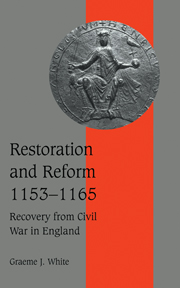Book contents
- Frontmatter
- Contents
- Preface
- List of abbreviations
- 1 The political context
- 2 The governance of England during Stephen's reign
- 3 Personnel and property
- 4 Financial recovery
- 5 The administration of justice
- 6 Conclusion
- Appendix I sheriffs' farms, 1130–65 and 1197
- Appendix II pipe roll, 11 Henry II (1164–5)
- Select bibliography
- Index
- Cambridge Studies in Medieval Life and Thought Fourth series
4 - Financial recovery
Published online by Cambridge University Press: 03 September 2009
- Frontmatter
- Contents
- Preface
- List of abbreviations
- 1 The political context
- 2 The governance of England during Stephen's reign
- 3 Personnel and property
- 4 Financial recovery
- 5 The administration of justice
- 6 Conclusion
- Appendix I sheriffs' farms, 1130–65 and 1197
- Appendix II pipe roll, 11 Henry II (1164–5)
- Select bibliography
- Index
- Cambridge Studies in Medieval Life and Thought Fourth series
Summary
INTRODUCTION
Although some royal revenues had continued to be levied during Stephen's reign – not always for the king – and although significant steps had been taken to recover income due to the crown in the months following the peace settlement, there was much to be done at Henry II's accession in the field of financial administration if the position in the closing years of Henry I was to be restored. The total raised for the king in the financial year 1129–30, according to the incomplete evidence of the pipe roll for that year, has been calculated at over £24,000; on the same basis, the income in 1155–6 has been put at only £13,000, although it had climbed to £19,000 by 1158–9 only to fall thereafter. There are several caveats to be entered against these figures, but their overall message is clear. A king who began his reign in debt and put a high priority on the assertion of his political rights – by military force where necessary – desperately needed to increase his income. Greater efficiency in the administration responsible for bringing in money and handling accounts was also essential. Accordingly, the financial dimension to the restoration of orderly royal government was of major concern to the king and his advisers.
- Type
- Chapter
- Information
- Restoration and Reform, 1153–1165Recovery from Civil War in England, pp. 130 - 160Publisher: Cambridge University PressPrint publication year: 2000



